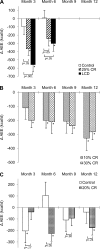Effect of calorie restriction on the free-living physical activity levels of nonobese humans: results of three randomized trials
- PMID: 21292847
- PMCID: PMC3075130
- DOI: 10.1152/japplphysiol.00846.2009
Effect of calorie restriction on the free-living physical activity levels of nonobese humans: results of three randomized trials
Abstract
The objective of this study was to evaluate the influence of calorie restriction (CR) on free-living physical activity levels among humans. Data were from three CALERIE phase I site-specific protocols. Participants were nonobese (body mass index = 23.5-29.9 kg/m² adults randomly assigned to 25% CR, low-calorie diet (LCD, 890 kcal/day supplement diet until 15% weight loss, then weight maintenance), or control at Pennington Biomedical Research Center (PBRC); 30% or 10% CR at Tufts University; and 20% CR or control at Washington University School of Medicine (WUSM). Activity was measured at months 0, 3, and 6 (PBRC) and at months 0, 3, 6, 9, and 12 (WUSM and Tufts). Total daily energy expenditure (TEE) by doubly labeled water and resting metabolic rate (RMR) were used to compute activity energy expenditure: AEE = TEE - RMR - 0.1 * TEE. Accelerometry and 7-day recall categorized activities by intensity. At Tufts, the 10% and 30% CR groups experienced significant decreases in AEE at months 6, 9, and 12. At month 6, a larger decrease in AEE was observed in the CR than the control group at WUSM. At months 3 and 6, larger decreases in AEE were observed in the CR and LCD groups than the control group at PBRC. Accelerometry and 7-day PAR did not consistently detect changes in activity categories. CR-associated changes in AEE were variable but, generally, reduced the energy deficit, which would reduce the expected rate of weight loss. Accelerometry and recall did not consistently explain reduced AEE, suggesting that increased muscle efficiency and/or decreased fidgeting accounted for decreased AEE. Inaccuracy of accelerometry and recall also likely negatively affected sensitivity.
Figures


Similar articles
-
Effect of calorie restriction on resting metabolic rate and spontaneous physical activity.Obesity (Silver Spring). 2007 Dec;15(12):2964-73. doi: 10.1038/oby.2007.354. Obesity (Silver Spring). 2007. PMID: 18198305 Clinical Trial.
-
Metabolic and behavioral compensations in response to caloric restriction: implications for the maintenance of weight loss.PLoS One. 2009;4(2):e4377. doi: 10.1371/journal.pone.0004377. Epub 2009 Feb 9. PLoS One. 2009. PMID: 19198647 Free PMC article. Clinical Trial.
-
Approaches for quantifying energy intake and %calorie restriction during calorie restriction interventions in humans: the multicenter CALERIE study.Am J Physiol Endocrinol Metab. 2012 Feb 15;302(4):E441-8. doi: 10.1152/ajpendo.00290.2011. Epub 2011 Nov 29. Am J Physiol Endocrinol Metab. 2012. PMID: 22127229 Free PMC article. Clinical Trial.
-
Physical activity as determinant of daily energy expenditure.Physiol Behav. 2008 Mar 18;93(4-5):1039-43. doi: 10.1016/j.physbeh.2008.01.021. Epub 2008 Jan 31. Physiol Behav. 2008. PMID: 18308349 Review.
-
Impact of calorie restriction on energy metabolism in humans.Exp Gerontol. 2020 May;133:110875. doi: 10.1016/j.exger.2020.110875. Epub 2020 Feb 11. Exp Gerontol. 2020. PMID: 32057825 Free PMC article. Review.
Cited by
-
Dietary Control of Inflammation and Resolution.Front Nutr. 2021 Aug 10;8:709435. doi: 10.3389/fnut.2021.709435. eCollection 2021. Front Nutr. 2021. PMID: 34447777 Free PMC article. Review.
-
Longitudinal assessment of physical activity in women undergoing Roux-en-Y gastric bypass.Obes Surg. 2015 Jan;25(1):119-25. doi: 10.1007/s11695-014-1331-x. Obes Surg. 2015. PMID: 24934315 Clinical Trial.
-
A Holistic Approach to Postendodontic Pain Management: A Narrative Review.J Pharm Bioallied Sci. 2024 Dec;16(Suppl 5):S4262-S4270. doi: 10.4103/jpbs.jpbs_1301_24. Epub 2025 Jan 30. J Pharm Bioallied Sci. 2024. PMID: 40061728 Free PMC article. Review.
-
The impact of Dietary Weight loss, Aerobic Exercise, and Daylong Movement on Social Cognitive Mediators of Long-term Weight loss.J Behav Med. 2023 Jun;46(3):499-508. doi: 10.1007/s10865-022-00359-6. Epub 2022 Oct 10. J Behav Med. 2023. PMID: 36215000 Free PMC article. Clinical Trial.
-
Long-term intake of total energy and fat in relation to subjective cognitive decline.Eur J Epidemiol. 2022 Feb;37(2):133-146. doi: 10.1007/s10654-021-00814-9. Epub 2021 Nov 8. Eur J Epidemiol. 2022. PMID: 34748116 Free PMC article.
References
-
- Allison DB, Paultre F, Goran MI, Poehlman ET, Heymsfield SB. Statistical considerations regarding the use of ratios to adjust data. Int J Obes Relat Metab Disord 19: 644–652, 1995 - PubMed
-
- Bandini LG, Schoeller DA, Cyr HN, Dietz WH. Validity of reported energy intake in obese and nonobese adolescents. Am J Clin Nutr 52: 421–425, 1990 - PubMed
-
- Carpenter WH, Poehlman ET, O'Connell M, Goran MI. Influence of body composition and resting metabolic rate on variation in total energy expenditure: a meta-analysis. Am J Clin Nutr 61: 4–10, 1995 - PubMed
-
- Das SK, Gilhooly CH, Golden JK, Pittas AG, Fuss PJ, Cheatham RA, Tyler S, Tsay M, McCrory MA, Lichtenstein AH, Dallal GE, Dutta C, Bhapkar MV, Delany JP, Saltzman E, Roberts SB. Long-term effects of 2 energy-restricted diets differing in glycemic load on dietary adherence, body composition, and metabolism in CALERIE: a 1-y randomized controlled trial. Am J Clin Nutr 85: 1023–1030, 2007 - PubMed
Publication types
MeSH terms
Grants and funding
LinkOut - more resources
Full Text Sources
Medical

